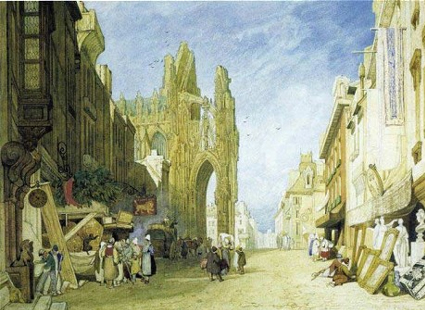“Cotman in Normandy”, at The Dulwich Picture Gallery.
John Sell Cotman remains a shadowy figure in the landscape of early nineteenth-century British art. Born in Norwich in 1782, he was, like many other English painters of his time, self-taught. In his youth he was close to the brilliant but short-lived Thomas Girtin, as well as to to J.M.W. Turner. Like his friends, Cotman was a pioneer of independent watercolour painting. Unlike them, he attained little fame in his own lifetime, spending much of his life as a teacher of drawing to the wives and daughters of Norwich notables.
He is best known for the melancholy watercolours of his early years: church spires the colour of mouldering cheddar, piercing turbulent skies full of fast-moving cloud; fine Gothic cathedrals drawn with a lacemaker’s precision, rising from the higgledy-piggledy structures of England’s old medieval towns; ruined choirs, bare mountains. They are an equivalent, in painting, to the early poetry of Wordsworth, Tintern Abbey or The Ruined Cottage: a solitary walker’s attempts to find meaning, or some fugitive sense of self-transcendence, in the derelict remains of the past and the mighty spectacle of nature.
A new exhibition of Cotman’s work at the Dulwich Picture Gallery opens with a small selection of such moodily introspective images: from 1801, a lowering depiction of the village of Brecknock, rising above the twinned picturesque arches of a crumbling bridge; from 1806, a grandly monumental view of Durham Cathedral, filigree-fine, its Gothic tracery outlined against a sky the colour of dirty snow. But the heart of the show lies elsewhere: “Cotman in Normandy” is its title. It focusses on the work Cotman produced between 1817 and 1820, on a series of three tours to Northern France, under the patronage of a banker and antiquarian named Dawson Turner. The result...


